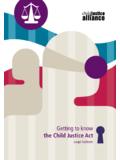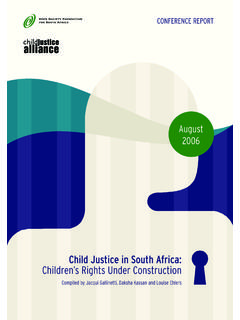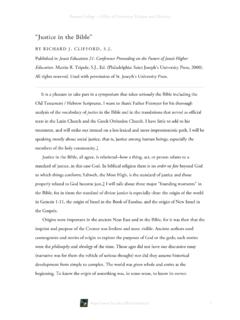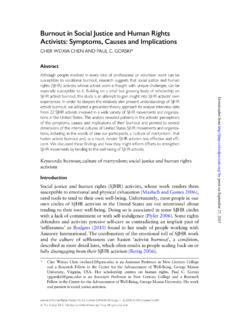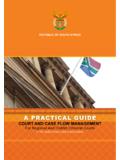Transcription of Children Used by Adults to Commit Crime Guidelines for ...
1 Children Used by Adults to Commit CrimeGuidelines for Role-players in the criminal justice SystemChildren Used by Adults to Commit Crime : Guidelines for Role-players in the criminal justice SystemPrepared By: Children s Rights ProjectCommunity Law CentreUniversity of the Western CapeFor:The Programme Towards the Elimination of the worst forms of Child Labour (TECL)A project in support of the Child Labour Programme of Action for South Africa Published byProgramme Towards the Elimination of the worst forms of Child Labour (TECL)c/o International Labour OrganisationBox 116940028 HatfieldEmail: Group for the CUBAC Pilot Projects:Inter-Sectoral Committee on Child JusticeChair: Department of justice and Constitutional DevelopmentMembers.
2 Department of Correctional ServicesDepartment of Social DevelopmentDepartment of EducationJustice CollegeLegal Aid BoardLower Court Management Committee / Magistrate's CommissionNational Prosecuting AuthorityOffice of the Rights of the ChildSouth African Police ServiceThis publication forms part of a series addressing Children Used by Adults to Commit Crime (CUBAC). Such use of Children is considered a worst form of child labour interms of the Worst Forms of Child Labour Convention of the International Labour Organisation. The initial series includes the following publications: Situation Analysis and Pilot Design Prevention Programme Manual Childrens Perceptions of their Use by Adults in the Commission of Offences Diversion Programme Manual Guidelines for Role-players in the criminal justice SystemCopies of these publications can be obtained from: The Children s Rights Project, Community Law Centre, University of the Western Cape, Private Bag X17, Bellville 7535.
3 Tel: +27 21 959 2950 Fax: +27 21 959 2411 Email: series was produced as part of the implementation of the Child Labour Programme of Action for South Africa, which is a national partnership initiated by the SouthAfrican government. Civil society partners comprise organised business, organised labour and non-governmental organisations. The overall lead government departmentis the Department of Labour, and the lead department on the CUBAC project is the Department of justice and Constitutional series relates to a set of pilot projects addressing CUBAC, which was designed by consultants contracted by the programme Towards the Elimination of the worst formsof Child Labour (TECL).
4 Regarding its programme in South Africa, TECL is an executing agency for key elements of the Child Labour Programme of Action, as a partner ofrelevant government departments, regarding their obligations. Funding for the pilot projects and for the publications was obtained from the US Department of Labour,through the International Labour views expressed in this publication are in all cases those of the writers concerned and do not necessarily reflect the views of the Department of Labour, the ILO, TECL,or any other No: 1-86808-624-0 Copyright The International Labour Organisation, 2006 Excerpts from this publication may be reproduced without authorisation, on condition that the source is of the objects of the Child justice Bill is to promote co-operation between all government departments and other organisationsand agencies involved in implementing an effective child justice system.
5 The Inter-Sectoral Committee on Child justice (ISCCJ) is theembodiment of this objective. The ISCCJ seeks to manage child justice issues at a national level through inter-departmental co-oper-ation and communication. The ISCCJ has been involved with the CUBAC project since its inception at the beginning of 2005, recognising that Children used byadults or older Children to Commit Crime are a particularly vulnerable group of young offenders. All of the representatives on the ISCCJ have engaged with the various aspects of the CUBAC project and, in particular, are of the opinion that a set of Guidelines for the various role-players would be of great benefit to the efficient management of Children who have been used by Adults to commitoffences.
6 The Guidelines and information contained in this publication will ensure a greater awareness not only of the CUBAC phenomenon ingeneral, but also certainty regarding the responsibilities of the various role-players within the criminal justice sector and how theserelate to this specific group of Children in trouble with the law. We encourage all actors within the child justice field to adopt these Guidelines and work together to ensure a truly co-operative andcommon approach to managing the instrumental use of Children in illicit activities.
7 Pat MoodleyChairpersonInter-Sectoral Committee on Child JusticeJanuary 20061 PageInternational Instruments2 UN Convention on the Rights of the Child International Labour Organisation: Convention 182 Other international documents4 United Nations General AssemblySouth African law5 The Constitution The Children s BillThe Child Labour Programme of Action for South Africa6 Risk indicators8 What do you do? Police9 What do you do? Probation officer10 What do you do? Prosecutor11 What do you do? Magistrate12 What do you do? Diversion service provider and Child care workers13 What do you do?
8 Legal Representative for the child14 What do you do? Educators15 Contents2 InternationalinstrumentsUNConvention on the Rights of the ChildArticle Parties recognise the right of every child alleged as, accused of, or recognised as having infringed the penal law to be treated in a manner consistent with the promotion of the child s sense of dignity and worth, which reinforces the child s respectfor human rights and fundamental freedoms of others and which takes into account the child s age and the desirability of promot-ing the child s reintegration and the child s assuming a constructive role in this end, and having regard to the relevant provisions of international instruments, State Parties shall, in particular, ensure that.
9 A) no child shall be alleged as, be accused of, or recognised as having infringed the penal law by reason of acts or omissions thatwere not prohibited by national or international law at the time they were committed;b) every child alleged or accused of having infringed the penal law has at least the following guarantees:(i) to be presumed innocent until proven guilty according to the law;(ii) to be informed promptly and directly of the charges against him or her, and if appropriate, through his or her parents orlegal guardians, and to have legal or other appropriate assistance in the preparation and presentation of his or herdefence.
10 (iii) to have the matter determined without delay by a competent, independent and impartial authority or judicial body in afair hearing according to law, in the presence of legal or other appropriate assistance and, unless it is considered not tobe in the best interests of the child, in particular, taking into account his or her age or situation, his or her parents or legalguardians;(iv) not to be compelled to give testimony or confess guilt; to examine or have examined adverse witnesses and to obtain theparticipation and examination of witnesses on his or her behalf under conditions of equality;(v) if considered to have infringed the penal law, to have this decision and any measures imposed in consequence thereofreviewed by a higher competent, independent and impartial authority or judicial body according to law;(vi) to have the free assistance of an interpreter if the child cannot speak or understand the language used.

